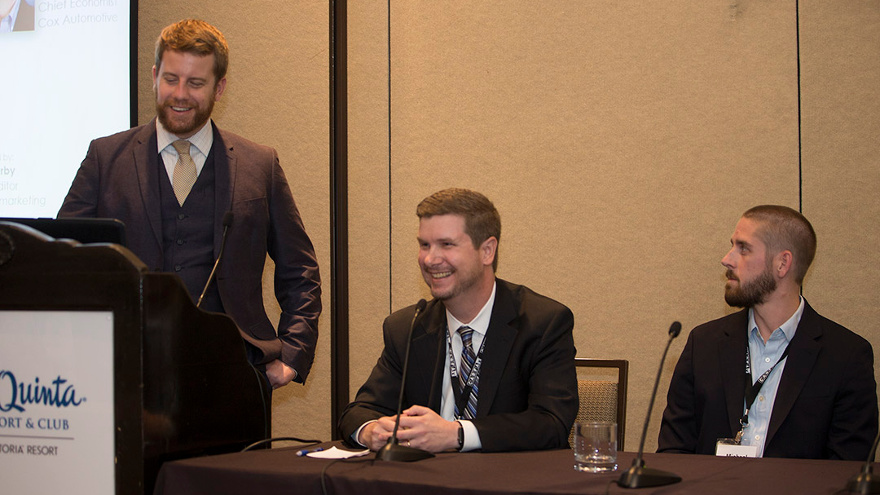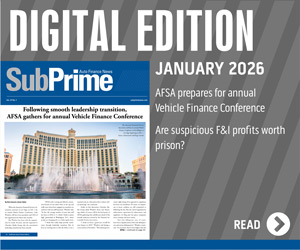2 Cox Automotive economists dissect implications of third interest-rate rise of 2017

Cox Automotive chief economist Jonathan Smoke chuckles with Auto Remarketing senior editor Joe Overby and Moody's economist Michael Vogan during a panel discussion at Used Car Week 2017 in La Quinta, Calif. (Photo by Jonathan Fredin)
By subscribing, you agree to receive communications from Auto Remarketing and our partners in accordance with our Privacy Policy. We may share your information with select partners and sponsors who may contact you about their products and services. You may unsubscribe at any time.
ATLANTA and WASHINGTON, D.C. –
For the third time this year, the Federal Open Market Committee (FOMC) at the Federal Reserve opted to push the target range for the federal funds rate higher by another 25 basis points to leave the reading at 1.25 percent to 1.50 percent.
Based on the expectation that the Fed will increase interest rates three times again in 2018, a pair of Cox Automotive economists on Wednesday projected the possible auto industry implications, including a forecast that has U.S. new-vehicle sales falling below 17 million next year.
The FOMC approved the rate increase by a vote of 7-2 with Charles Evans and Neel Kashkari preferring to maintain the existing target range for the federal funds rate when the Fed hosted its last meeting. The committee’s statement explaining its action reiterated how the group is charged with fostering maximum employment and price stability. The policymakers then turned their attention to what’s happened during the last two quarters of the year.
“Hurricane-related disruptions and rebuilding have affected economic activity, employment, and inflation in recent months but have not materially altered the outlook for the national economy,” the committee said in its statement. “Consequently, the committee continues to expect that, with gradual adjustments in the stance of monetary policy, economic activity will expand at a moderate pace and labor market conditions will remain strong.
“Inflation on a 12‑month basis is expected to remain somewhat below 2 percent in the near term but to stabilize around the committee’s 2 percent objective over the medium term. Near-term risks to the economic outlook appear roughly balanced, but the committee is monitoring inflation developments closely,” the group added.
The Fed’s actions now have pushed interest rates a full percentage point higher than a year ago. Cox Automotive chief economist Jonathan Smoke explained what those decisions have meant to dealerships trying to get vehicles rolled over the curb and finance companies looking to fill their portfolios with performing paper.
Subscribe to Auto Remarketing to stay informed and stay ahead.
By subscribing, you agree to receive communications from Auto Remarketing and our partners in accordance with our Privacy Policy. We may share your information with select partners and sponsors who may contact you about their products and services. You may unsubscribe at any time.
“We are already seeing the impact of higher rates and tighter credit on auto sales as the Fed increased short term rates three times over the last year,” Smoke said in a statement distributed by Cox Automotive. “Comparing this November to last November, we are seeing higher lease payments and fewer new leases. The average interest rate on new-vehicle loans, however, has only increased by 20 basis points, resulting in only a $12 increase to the average monthly payment. For lower credit borrowers though, the increase has been far more substantial, rising by nearly a full percentage over the last year.
“The monthly payment matters,” Smoke emphasized.
The latest metrics from Experian Automotive showed that the average payment was $502 per month for new vehicles, increasing by $6 over the previous year, while used-vehicle payments averaged $365 per month, up $3 from the previous year. Those averages arrived as the volume of deep subprime market share sunk to the lowest point analysts have ever seen.
“When rates rise, many consumers do not have an option to pay more. We believe higher rates have already led the automotive market to see some shift away from new and into used,” Smoke said.
“In 2017, it has meant sales of nearly new pre-owned vehicles increased dramatically at the expense of new vehicles as borrowers who would have qualified for a new loan or lease a few years ago are now more likely to buy used. As rates go higher, we expect this trend to continue,” he continued.
Cox Automotive senior economist Charlie Chesbrough echoed many of the points Smoke made, stressing that the Fed’s decision this week likely won’t trigger desolate scenes at dealership showrooms and finance company underwriting departments. But Chesbrough did concede that if the Fed keeps pushing interest rates higher, the rippling impact could spread.
“The Fed’s move today will not derail the market from its strong pace,” Chesbrough said. “Over time though, higher rates will have a negative effect on sales. Consumers could face slightly higher costs for all their borrowing — credit card balances, student loans, financing a house or a car. At the same time, higher rates drive up the cost to provide low-rate financing, which eats into profit margins and hurts the carmakers as well.”


